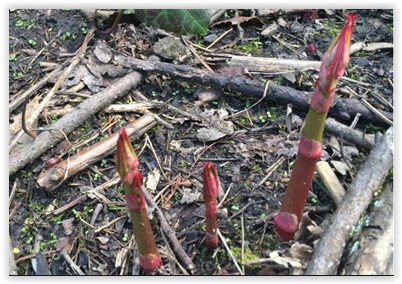Motives for adding to our horticultural riches by plant collectors abroad can be economic.Other factors can lead to the unwelcome addition to our native flora by the rampaging habits of invasive alien plants by pure accident, or the wilful dumping of unwanted plants in the wider countryside.
Japanese Knotweed (Reynoutria japonica, alias Fallopia japonica) must be the most notorious. It has such bad publicity that there are possibly apocryphal accounts of would-be house buyers having been refused a mortgage if this plant has been seen on the premises.
 |
| This says it all. |
 |
| This herbaceous perennial appears as red spears in the spring. |
 |
| Japanese Knotweed rapidly grows into a dense clump at least 6 feet high. |
 |
| Its flowers form attractive foamy white sprays. |
Introduced from Japan to Holland in 1850 as a single female plant, it was then given to Kew and passed into the horticultural trade. It has subsequently spread, naturalized and established throughout the gardening world and thus into the wild. All from the one original female clone!
It grows from a stout woody underground stem or rhizome which in time will produce an impenetrable mat just below the surface, smothering all other growth, aided by the tall dense overshadowing top growth. Nowadays its rampant behaviour is leading to efforts to spray and kill all reported colonies on public land and it is illegal to spread even fragments of the plant outside your own property.
Himalyan Balsam (Policeman’s Helmet) (Impatiens
glandulifera) is another now unwelcome Far Eastern introduction. This hugely
tall luxuriant annual plant with big handsome flowers attracts attention and
curiosity. I’ve been asked several times if it’s an orchid, but it is in fact related to the Busy Lizzie.
 |
| Its showy pink or sometimes white flowers are a rich source of nectar for Bumble Bees. |
It favours damp soil and it will rapidly spread throughout river systems. The capsules explode when mature, catapulting the seed many feet, to the delight of children and giving it another name, Touch-me-Not. The seed has a spongy covering so it floats on water and travels downstream where the seedlings will germinate the following spring and produce a dense smothering forest of robust plants, only controllable by pulling or cutting before the flowers mature.
Eucalyptus species (mainly Eucalyptus globulus the Tasmanian blue Gum) have in the past been planted and grown in many parts of Portugal and Spain as a fast-growing commercial timber crop.
It matures, flowers and seeds prolifically and its hard leathery leaves when shed, make a thick layer on the ground, very slow to rot and so they smother and overshadow any native ground flora. Now there seem to be efforts to cut and eradicate this result of the law of unforeseen consequences but commercial interests always seem to ignore the well known 'Rabbits in Australia' lesson until it’s too late.
 |
| Eucalyptus grown as a commercial crop in Spain and Portugal. |
 |
| Dense growth of Tasmanian Blue Gum in Spain. Once established, it will seed itself. |
 |
| Another commercial use of Eucalyptus, an 'essential oil'. |

Eucalyptus globulus (Tasmanian Blue Gum) flowers.
Sydney Wattle (Acacia longifolia) This attractive tree, endemic to SE Australia but now naturalized in SW Western Australia and introduced to South Africa as a plant regarded as suitable for stabilizing sandy soils and dune systems has been such an enthusiastic thug that strenuous efforts are being made in the Cape Province for example, to eradicate it.
 |
| Sydney Wattle. |
 | |
| Hottentot Fig. |
Yet another genii that has got out of the bottle is Hottentot Fig (Carpobrotis edulis) this one a present FROM South Africa! A vigorous succulent plant, it has escaped from gardens and at least along the south coast of Britain, where it is largely free from frosts, it has spread in numerous places to form impenetrable mats which again smother out the less vigorous native coastal plants.
Additions to a country’s flora have always slowly happened as a result of chance, mostly only surviving for a short time before they succumb to conditions they aren’t suited to. It’s the very vigorous and adaptable kinds which survive and elbow their way in. The horticultural trade worldwide has exacerbated the problem, spreading unwelcome guests (and too often their pests and diseases too) across the planet.
No comments:
Post a Comment